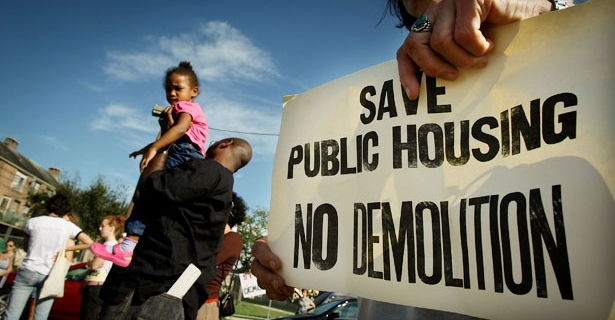Deploying Urban Space
http://www.inthesetimes.com/article/13182/deploying_urban_space/

Demolition opponents rally outside New Orleans' St. Bernard public housing development on Dec. 15, 2007. The projects were torn down in 2008. (Mario Tama/Getty Images)
The high-rise public-housing projects that stood as monuments to failed federal policy and desperate urban poverty through the second half of the 20th century are nearly gone. Conceived in the 1930s as visionary solutions to the problem of deteriorated tenements, by the 1960s the modernist towers were viewed as “warehouses” for the urban African-American poor. St. Louis’ reckoning was among the earliest and most spectacular: The 1972 photograph of the implosion of one of the infamous Pruitt-Igoe towers marked “the death of modernism.” It was another three decades before Chicago’s most notorious projects, Cabrini Green and the massive Robert Taylor Homes, were torn down.
Left behind is an urban landscape shorn of almost all remnants of public housing’s brutal history. In St. Louis, 33 acres of the original 57-acre Pruitt-Igoe site have become an urban wilderness, a dense forest just north of the city center.
Most of Chicago’s Cabrini Green is now neat rows of town houses edging a public park and library. What’s covered over by this new bourgeois neighborhood are the radical ideals (and idealists) who imagined government could provide decent housing for urban residents; the racist city and federal policies that quickly destroyed the housing; and the displaced residents who attempted to make homes out of deteriorating high-rises.
Spaces, as French sociologist Henri Lefebvre famously observed, obscure the conditions of their own production. Almost as soon as construction is complete, buildings, parks, roads and bridges – the built environment – take on an air of inevitability, as if the city emerged naturally through an organic process. The appearance of natural growth hides dramatic inequalities in the distribution of political power, social resources and urban infrastructure. In fact, the language of evolution so often applied to urban development tends to render those inequalities as natural outcomes of organic processes. Among Lefebvre’s great contributions was to shake off the organic metaphors and focus attention on the social processes of producing cities. Cities are formed historically, the results of political struggles and competing economic interests.
